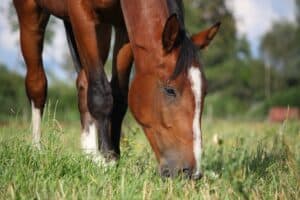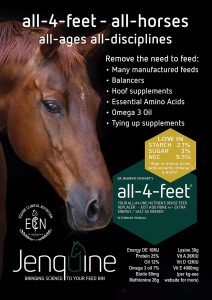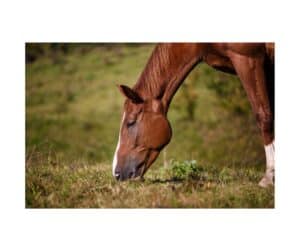Spring pasture: Tips for a smooth transition
Spring grass grows rapidly, is up to 80% water, low in fibre, soft and easy to chew. There’s little horses and ponies relish more than the sweet taste of spring grass. But if horses overindulge on the new grass, virtually all of them can have a degree of digestive upset – mostly seen as looser, greener, more watery manure due to the high water content of the grass.
There are several things you can do to limit digestive upsets. Most are quite simple and easy:
- Sudden changes in diet can be a risk factor for colic so it is advisable to keep feeding some hay while they are out at pasture so you are not completely switching from all grass to all hay
- Feed some hay to provide fibre – horses may crave fibre and chew fence posts and bark if they don’t have enough
- Also add some beet pulp which is an excellent prebiotic and supports gut health and ½ to 1cup of psyllium during the spring transition can also help the gut transition to the new diet
- Feeding hay will also curb your horses appetite and reduce the amount of grass they need and over-eating
- To allow the gut to adapt to the changing grass, limit grazing and gradually increase over a few weeks – start with up to an hour and increase by 30 minutes each day, until the horse has adjusted to 3 to 4 hours grazing period. After 2-4 weeks, the gut will have adapted to the new diet and your horse may be able to have unlimited grazing.
- Limit grazing to between 3am (for early-risers!! – otherwise, whenever you get up) and bring them in at around 11am – before photosynthesis from sunlight has allowed the grass to make heaps of sugar
- Some horses and ponies are especially clever and if you set a time limit on how long they can graze, they will increase their feeding rate. Ponies are the worse culprits and can gobble own their whole daily energy needs in a few hours!
- Grazing muzzles help to restrict and slow grass intake – very useful if your horse is too forward in condition or prone to laminitis. Some horses can’t seem to understand how to use the muzzle and won’t graze at all – while others figure out how to still eat more grass than they need even with a muzzle – keen observation is important.
- Keep an eye also on your horse’s appetite and manure and any hint of foot pain, lameness, heat in the hooves, or signs of colic – if these occur call your vet
- Also watch the girthline and amount of fat on the neck crest, tail head and in front of the udder and prepuce – if these increase, weight management is needed
- If your horse has a history of founder or laminitis, you may not be able to let them have any pasture – discuss this with your vet if you’re uncertain
- Regular mowing reduces the amount of sugar the grass can store, making it safer for animals at risk for laminitis
As well as the digestive system, your horses behaviour may change in spring. Sometimes this is called ‘spring madness’ when horses can become more reactive or anxious. For many horses, the low magnesium content of spring grass causes a behaviour change and a correctly formulated magnesium supplement is calming and reduces their symptoms.

Pasture is a wonderful source of nutrition for most horses, but care must be taken when grazing spring grass. Sudden feed changes wreak havoc on a horse’s gut – abrupt changes including switching grains, hay types or going from hay to pasture, do not give the gut enough time to adjust and this can cause colic or diarrhea in any horse. Spring grass is definitely in the category of a diet change and even with careful management it is not unusual to see digestive upsets at this time. Spring grass is recognised as a risk for issues such as diarrhoea and horses can develop bright green diarrhea and bloating.
Dealing with spring pasture may be time-consuming and stressful for both you and your (muzzled) horse, but consider that laminitis is a far worse fate. Keep in mind the ‘golden rule’ of horse feeding – ‘make any change gradually’.
DISCLAIMER All content provided in this article is for general use and information only and does not constitute advice or a veterinary opinion. It is not intended as specific medical advice or opinion and should not be relied on in place of consultation with your veterinarian.
More information on equine nutrition is available at www.jenquine.com
Meet the author and PCA’s resident equine nutritionist
Dr Jennifer Helen Stewart
BVSc BSc PhD Dip BEP MRCVS
Equine Veterinarian and Consultant Nutritionist – CEO Jenquine

Dr Jennifer Stewart is an equine veterinarian with over thirty five years’ experience. She is also a consultant nutritionist and has formulated feeds, custom mixes and supplements for leading international horse feed manufacturers in Australia, India, Ireland, Japan, New Zealand, Philippines, South Africa, Thailand, Turkey and the UAE. Dr Stewart is passionate about equine nutrition and its role in the management, treatment and prevention of many equine diseases. She is committed to bringing ‘science to the feed bin’.
Dr Stewart graduated BSc (vet) and BVSc at the University of Sydney. Her research thesis was “Resistance of Equine Strongyles to Benzimidazole Anthelmintics” and her PhD “Studies on Heart and Lung Function in Foals”. She worked at the Universities of North Carolina, Michigan and Florida USA in equine medicine, antibiotics and exercise physiology. Following this was a time spent in Newmarket and Cambridge England, in stud and race track research and practice, before establishing an exclusively equine practice on the Central Coast of NSW Australia. She has been an official veterinarian for the Australian Jockey Club for over 20 years, was one of the team of equine veterinarians for the Sydney 2000 Olympic Games and consultant nutritionist for Mitavite for 10 years.
Dr Stewart has spent over twenty five years working on collaborative research projects into gastrointestinal and exercise physiology with major Universities; lecturing and supervising university and TAFE students; consulting to veterinary practices, trainers, pony clubs, owners, equestrian centres and studs; speaking at seminars in Australia, Middle East, South Africa, Philippines, SE Asia, Hong Kong, Japan, Turkey, India and New Zealand, and writing regularly for equine industry magazines. This experience in research, equine medicine and veterinary practice has given Dr Stewart a deep understanding of the complexities of equine health and performance; growth and development of young horses, and feeding practices for the management and prevention of diseases.
Watch Dr Stewart talk about her first love of horses and why she chose to become a vet in this short clip. Pony Club Australia is grateful for Dr Stewart preparing this laminitis article for our Horse Resource page. Please browse her other articles, blog and resources at Jenquine.



